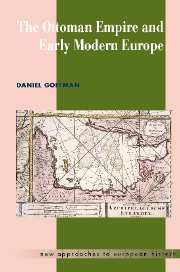Book contents
- Frontmatter
- Contents
- List of illustrations
- List of maps
- Preface
- Acknowledgements
- Note on usage
- Chronological table of events
- The Ottoman House through 1687
- 1 Introduction: Ottomancentrism and the West
- Part 1 State and society in the Ottoman world
- Kubad's formative years
- 2 Fabricating the Ottoman state
- Kubad in Istanbul
- 3 A seasoned polity
- Kubad at the Sublime Porte
- 4 Factionalism and insurrection
- Part 2 The Ottoman Empire in the Mediterranean and European worlds
- Glossary
- Suggestions for further reading
- Index
- NEW APPROACHES TO EUROPEAN HISTORY
Kubad in Istanbul
from Part 1 - State and society in the Ottoman world
Published online by Cambridge University Press: 05 June 2012
- Frontmatter
- Contents
- List of illustrations
- List of maps
- Preface
- Acknowledgements
- Note on usage
- Chronological table of events
- The Ottoman House through 1687
- 1 Introduction: Ottomancentrism and the West
- Part 1 State and society in the Ottoman world
- Kubad's formative years
- 2 Fabricating the Ottoman state
- Kubad in Istanbul
- 3 A seasoned polity
- Kubad at the Sublime Porte
- 4 Factionalism and insurrection
- Part 2 The Ottoman Empire in the Mediterranean and European worlds
- Glossary
- Suggestions for further reading
- Index
- NEW APPROACHES TO EUROPEAN HISTORY
Summary
Be damned, O Emperor, be thrice damned
For the evil you have done and the evil you do.
You catch and shackle the old and the archpriests
In order to take the children as Janissaries.
Their parents weep and their sisters and brothers too
And I cry until it pains me;
As long as I live I shall cry,
For last year it was my son and this year my brother.
The çavuş Kubad, journeying from Istanbul to the most Christian Serenissima as a representative of his sultan, felt uneasy. His visit to Christendom seemed an eerie adventure, but he was unsure why. It was not dread of the infidel creed. Some of his closest acquaintances had been claimed by the devşirme: snatched from their Christian towns and villages in the Ottoman Balkans, declared His Most Imperial Majesty's personal property, persuaded as boys to convert to Islam, and trained to become Ottoman soldiers and bureaucrats. Indeed, such had been the career path of his own grand vizier, Sokollu Mehmed Pasha, who had grown up a Christian on the Ottoman borderlands of Bosnia, been “tithed” into imperial service and converted, worked his way brilliantly up the administrative ladder in the imperial palace, served as the recently deceased Süleyman's last grand vizier, became also an imperial grandson-in-law by marrying İsmihan sultan, that padishah's favorite granddaughter, and now, as both grand vizier and son-in-law to the new Sultan Selim II, was arguably the most influential person in the entire realm.
- Type
- Chapter
- Information
- The Ottoman Empire and Early Modern Europe , pp. 55 - 58Publisher: Cambridge University PressPrint publication year: 2002

